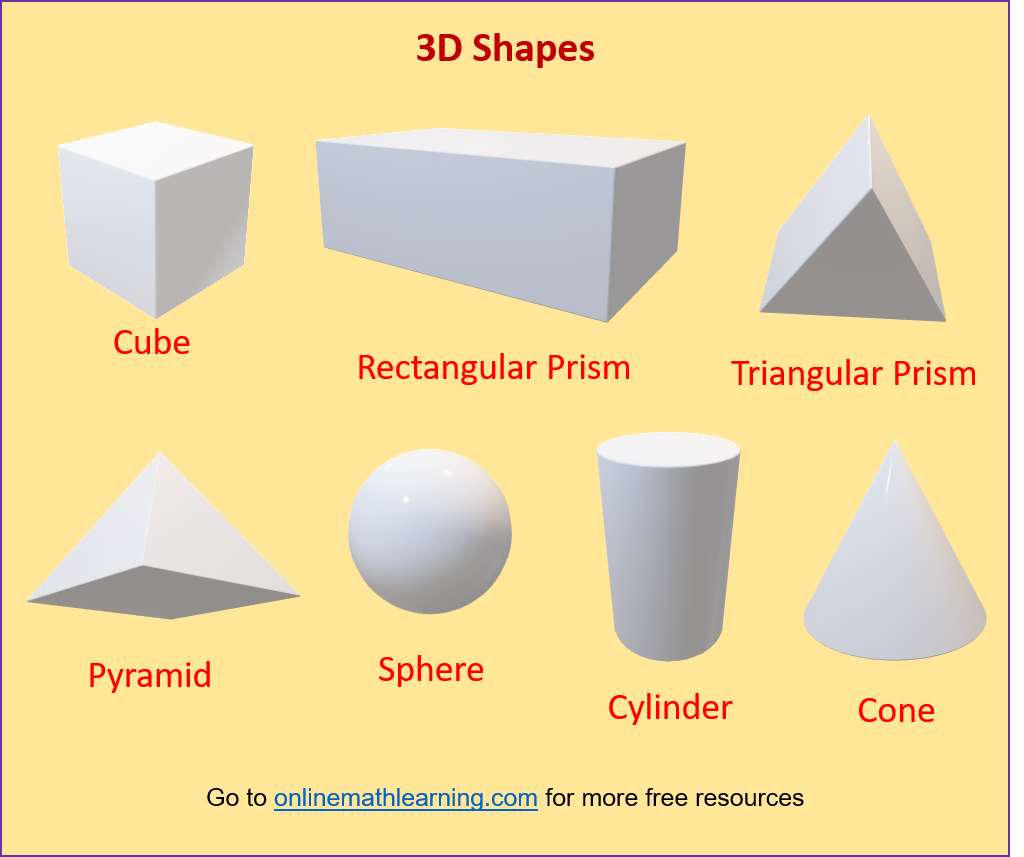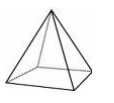3-D Objects - Grade 3
Related Topics:
More Grade 3 Math Topics
Videos, worksheets, games and activities to help Grade 3 students learn to describe 3-D objects according to the shape of the faces and the number of edges and vertices.
In these free math lessons, we will learn 3-D objects such as pyramids, prisms, cylinders, cones and spheres and their nets.
The following diagrams show some 3D shapes: cubes, prisms, pyramids, cylinders, cones and spheres. Scroll down the page for more examples and explanations.

-
2D and 3D Shapes Worksheets
Printable
Recognizing 2D Shapes (Kindergarten)
Recognizing 3D Shapes (Kindergarten)
Drawing 2D Shapes (Kindergarten)Sides & Corners (First Grade)
2D Shapes (First Grade)
Divide Shapes (Halves & Quarters)Shapes & Attributes (2nd Grade)
Polygons (2nd Grade)
Quadrilaterals (2nd Grade)
Composite Shapes (2nd Grade)
Divide Composite Shapes (2nd Grade)
Divide Circles & Rectangles
Relate Square to Cube (2nd Grade)Classify Quadrilaterals (3rd Grade)
Classify Polygons (3rd Grade)Lines of Symmetry
Types of Triangles
Classify Quadrilaterals (4th & 5th Grade)Online
Quadrilateral Properties
Angles in a QuadrilateralAngles in Polygons
Interior Angles in Polygons
Exterior Angles in Polygons
Pyramid
A face is a surface on a geometric object. An edge occurs when two faces of a 3-D object meet. A vertex is a point where three or more edges meet. In a pyramid, the vertex is the highest point above a base.
A pyramid has one base. The base is a special face that determines the name of the pyramid. The remaining faces in a pyramid are always triangles that meet at one point or vertex.

A pyramid with a square base is a square pyramid. A square pyramid has 5 faces, 8 edges and 5 vertices.

A pyramid with a triangular base is a triangular pyramid. A triangular pyramid has 4 faces, 6 edges and 4 vertices.
Prism
A prism has 2 bases that are matching polygons. The 2 bases are special faces that determine the name of the prism. The other faces are rectangles.

A prism with 2 rectangular bases is a rectangular prism. A rectangular prism has 6 faces, 12 edges and 8 vertices.
Note that a cube is a special rectangular prism with 6 equal square faces.

A prism with 2 triangular bases is a triangular prism. A triangular prism has 5 faces, 9 edges and 6 vertices.
Cylinder, Cone, Sphere

A cylinder is a 3-D object with 2 flat faces (which are circles), 1 curved face, 2 edges and 0 vertices.
A cone is a 3-D object with 1 flat face (which is a circle), 1 curved face, 1 edge and 1 vertex.
A sphere is a 3-D object with 1 curved face, 0 edges and 0 vertices.
3D-shapes: Faces, vertices and edges
How to find edges and vertices. Cubes, triangular pyramids, square based pyramids, and an explanation of edges, vertices and faces.
Nets of 3-D Objects
A net can be described as a ‘jacket’ for a geometric solid that can be folded to cover or create the surface of the solid. A net is a two-dimensional figure with indicated lines for folding to create a three-dimensional solid.
Geometric nets are matched with their corresponding shapes. Movies of the folding of the geometric nets are included.
Try out our new and fun Fraction Concoction Game.
Add and subtract fractions to make exciting fraction concoctions following a recipe. There are four levels of difficulty: Easy, medium, hard and insane. Practice the basics of fraction addition and subtraction or challenge yourself with the insane level.

We welcome your feedback, comments and questions about this site or page. Please submit your feedback or enquiries via our Feedback page.